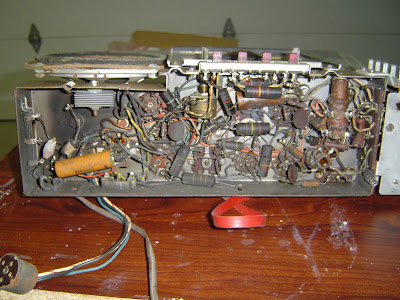Wow, it's hard to believe that it's been over two years since my last post. Normally, that would be indicative that I'd lost interest in doing so, but the real reason is simply that I haven't done much in the way of radio projects because of a couple of major, unrelated projects that I've been working on for the past couple of years.
One project involves a mobile home in a senior citizens complex in Central Florida, but we won't get into that, this being a radio and not a mobile home improvement blog, other than to say that the complex prohibits antennas but allows flagpoles. I knew that was something I could work with, I just didn't know how, but the idea had been planted.
Before continuing, there is a vendor who markets a ready-to-go, turnkey flagpole antenna for under a grand. Unless you like the adventure of rolling your own, that's probably a better way to go. For the rest of you sickies:
While this project was festering in the mucky recesses of my mind, I picked up one of those Chinese N7DDC ATU-100 autotuners from Amazon, and was pleasantly surprised by how well it worked; it operated quite quickly and reliably matched almost anything I threw at it, so I wondered how it might do as a remote tuner for a flagpole vertical. The answer: Quite well.
 |
| Remote ATU-100 tuner in weatherproof box. |
Having convinced myself that the idea might just work, I ordered a 25' telescoping flagpole (About $80 from Amazon.) The base section of the flagpole slips into a thin plastic sleeve, which I discovered fits reasonably well into 2 1/2" PVC. So, I cut a 3' section of this, glued a 19" section of 2" PVC inside of it so that, when planted in the ground, the base of the flagpole rests just above ground level, on top of the 2" PVC section. A hole is drilled near the base for the connection from the tuner, and just below that hole is the connection point for the ground radials. A short length of ladder line connects the antenna to the remote tuner.
 |
| PVC Base and tuner. |
From the remote tuner to the shack are two cables: One coaxial feedline and one power/control cable. On the bottom of the remote tuner, an SO-239 connects the feedline and a common 8 Pin mic socket the control cable, for which I used direct-bury lawn irrigation cable.
 | |
| Tuner controls mounted in Astron Supply. |
Being somewhat space-limited in the shack, I mounted the power and control switches/wiring in my Astron supply. Another 8 pin mic connector is installed on the rear of the supply for the control cable.
Operationally, the antenna/tuner will find a "match" on all the HF bands, automatically, within about a second of detecting a carrier or more than a handful of watts. Obviously, as a short, vertical radiator, radials are essential and mine are less than optimal, so my performance on the lower frequency bands (160, 80, 60) isn't as good as it could be, but it works. On 40, things get better, and on 30 and higher, it works quite well.
Quite well, indeed, considering that it's not an antenna.














